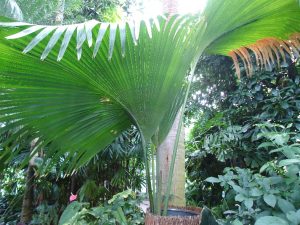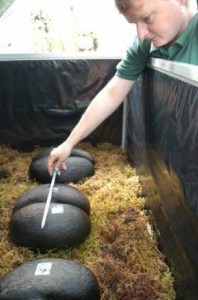Lodoicea maldivica
This remarkable palm, with its spectacular double-barrelled fruit, has had an intriguing history ever since it was first documented as Coco das Maldivas (coconut of the Maldives) in 1563. It is the largest seed in the world.
A Nautical Mystery
For many years, pioneering sailing ships had encountered the curious, provocatively anatomical fruit floating on the sea. It was nicknamed the ‘Coconut of the sea’ (hence its name Coco de Mer). It was only after the expedition of Chevalier Marion Dufresne landed in the Seychelles two centuries later, in 1768, that its association with a terrestrial palm tree was finally recognised.
The Royal Botanic Garden Edinburgh Specimen
Regius Keeper, Prof Stephen Blackmore (who serves on the Conservation Board which oversees the island of Aldabra and thus makes regular visits to the Seychelles), made arrangements, in 2003, for the Garden to receive seed from the Victoria Botanic Garden on Mahé. This finally germinated in 2005 and the radicle emerged and took root. Careful nurturing in the research glasshouses led to the establishment of this rapidly-growing specimen, which has recently been planted in the heart of the Tropical Palm House. Perhaps, by mid-century, it will both be a worthy successor to the historic sabal palm (if that outgrows the roof) and, with good fortune, we may even rear our first spectacular double coconut!
CLICK HERE TO GO TO NEXT PALMThis post is part of The World of Palms Glasshouse Trail



1 Comment
1 Pingback